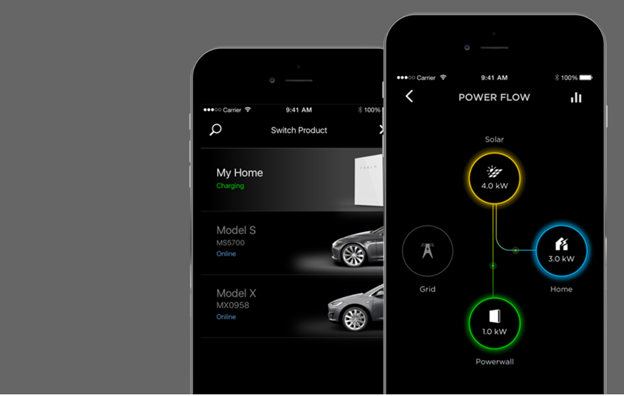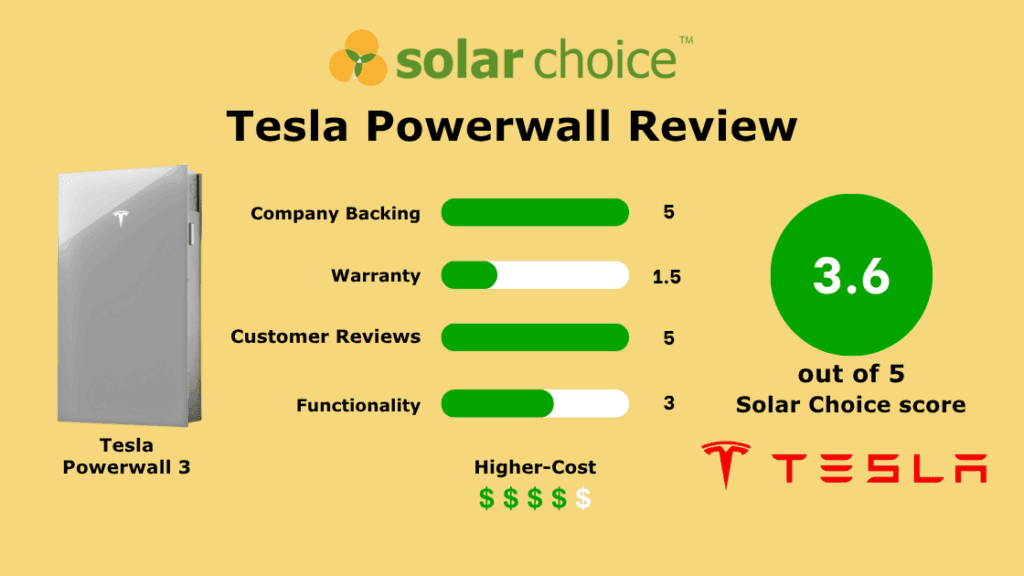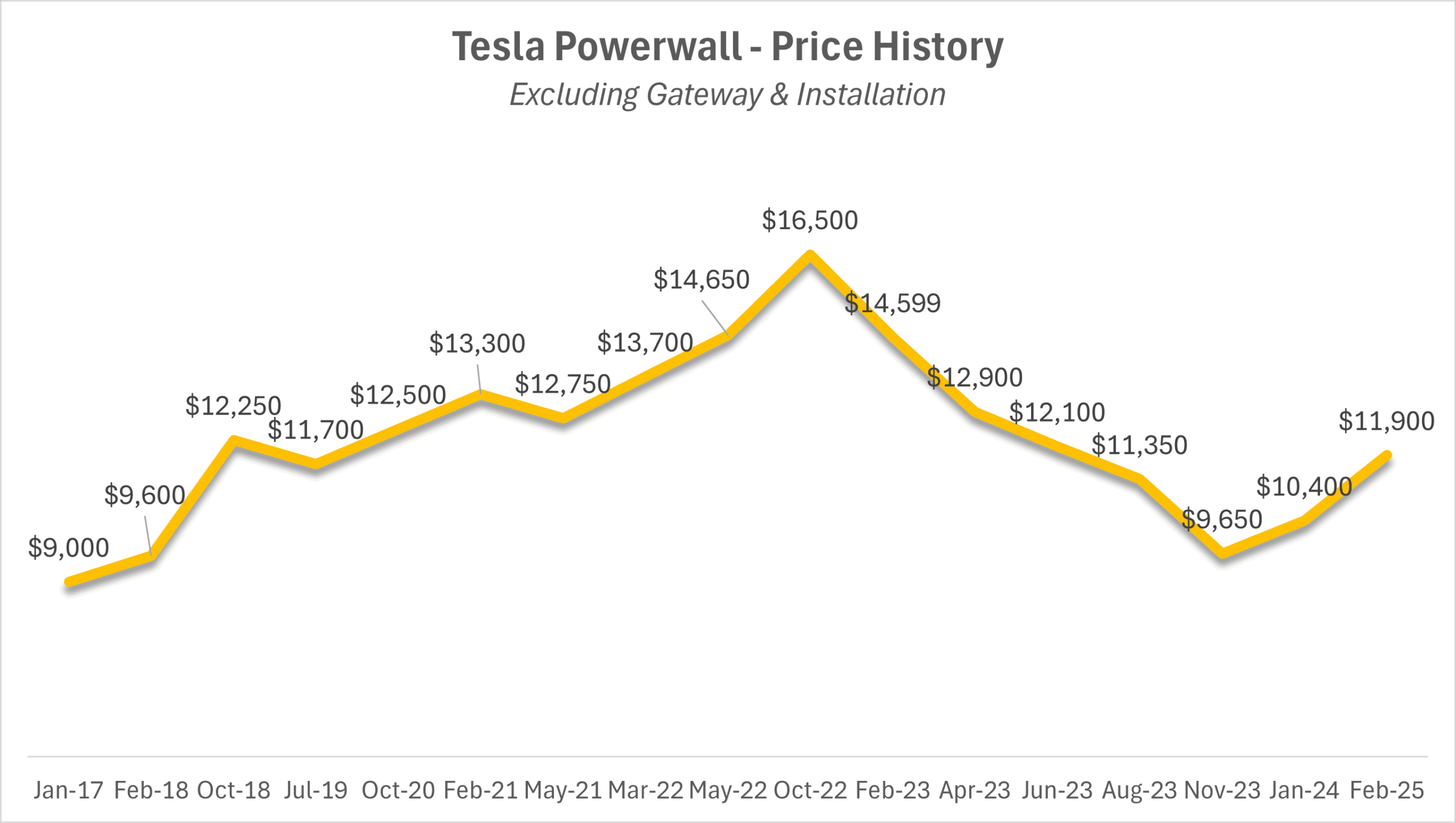Solar Choice has no reason to promote Tesla in this Tesla Powerwall 3 review and our battery articles are independent written and unbiased.
At a Glance: Tesla Powerwall 3 scores 3.6 out of 5
Scoring is based on our solar battery scorecard which is consistently applied to each brand and battery available on the Australian market. This scoring reflects Tesla’s Powerwall 2 system.
$$$ Price: Based on data from Solar Choice’s network of solar installers, the average price for an installed Tesla battery is $1,129 per usable kWh. This places it in the higher-cost price range.
- Company Backing and Trustworthiness (5 out of 5): Tesla has been operating in the Australian market since 2015 and is backed by one of the world’s largest and most recognised energy companies. The company has more than 20 staff in Australia and a long-standing global presence, earning it a perfect score in this category.
- Warranty Offer (1.5 out of 5): Tesla offers a throughput warranty of 2.8MWh per usable kWh unless only used for basic functions. It also comes with a 10-year product warranty and a maximum degradation of 30%. Despite the strength of Tesla’s brand, the throughput value results in a below-average score for warranty coverage.
- Customer Reviews (5 out of 5): Tesla batteries have received outstanding feedback from verified customers, with an average score of 4.78 from 161 reviews on Solar Choice’s independent platform. This earns a perfect score under our customer review framework.
- Functionality (3 out of 5): Tesla’s Powerwall meets most of the key functionality benchmarks. It is IP67 rated for outdoor use and includes a built-in inverter to enable an AC connection to existing solar systems. However, it lacks fire suppression and modular expansion. The battery capacity can only be expanded by adding additional full 13.5kWh batteries which is not cost effective.
Overview and History of Tesla Powerwall
How Much Does The Tesla Powerwall 3 Cost?
Tesla Powerwall Price Change History (excluding Gateway):
| Date | Wholesale Price | Change |
| 2017 | $9,000 | |
| 2018 – February | $9,600 | +$600 |
| 2018 – October | $12,250 | +$2,650 |
| 2019 – July | $11,700 | -$550 |
| 2020 – October | $12,500 | +$800 |
| 2021 – February | $13,300 | +$800 |
| 2021 – May | $12,750 | -$550 |
| 2022 – March | $13,700 | +950 |
| 2022 – May | $14,650 | +$950 |
| 2022 – October | $16,500 | +$1,850 |
| 2023 – February | $14,599 | -$1,901 |
| 2023 – April | $12,900 | -$1,699 |
| 2023 – June | $12,100 | -$800 |
| 2023 – August | $11,350 (after rebate) | -$750 |
| 2023 – November | $9,650 (after rebate) | -$1,700 |
| 2024 – January | $10,400 | +$750 |
| 2025 – February (PW3) | $11,900 | +$1,500 |
Tesla Powerwall 2 Discontinued? What It Means for Australian Homeowners
With the Tesla Powerwall 3 rollout, the Tesla Powerwall 2 has been discontinued in Australia.
For the most part the Powerwall 3 offers the same or better technical specifications to the Powerwall 2 including a larger built in PV inverter.
What if I already have a Powerwall 2?
Unfortunately the Tesla Powerwall 3 is not compatible with the Tesla Powerwall 2 so homeowners are unable to expand existing Powerwall 2 systems. Also the Powerwall 3 model can only be expanding to 4 parallel units where as the Powerwall 2 could be expanded to 10 units.
So it seems that Tesla’s newer model is mainly focused on new solar and battery customers and was not designed with existing solar customers in mind.
The Chemistry of a Tesla Powerwall 3
Tesla Powerwall Backup Gateway
Compare solar and battery quotes from local installers now.
Tesla Powerwall 3 Pros & Cons
Pros
- Depth Of Discharge (DoD): Excellent specifications including 100% DoD.
- Retrofit Capability: Easily integrates with third-party solar inverters, making it versatile for existing solar setups.
- High Power Output: The built in inverter can provide a continuous output of 11kW which can cover pretty much any combination of major household appliances.
Cons
- Expensive: One of the most expensive battery solutions on the market
- Not designed for 3-phase applications: as you can only connect the battery to one phase.
- One size fits all: The Tesla Powerwall 3 comes in one size (13.5kWh) with a built in 10kW inverter which limits consumers ability to get the optimal battery size for their needs.
Tesla Powerwall 3 Performance Specifications
| Specification | Tesla Powerwall 3 | Relevance to Homeowner |
|---|---|---|
| Usable Capacity | 13.5 kWh | Determines how much energy can be stored and used during non-solar hours. |
| Power Output (Continuous) | 11.04 kW | Indicates how many household appliances can be powered simultaneously. |
| Power Output (Peak) | Up to 15.6 kW (3 sec) | Handles short bursts of high energy demand (e.g. motor start-up). |
| Built-in Inverter | Yes – 11 kW hybrid inverter | Simplifies installation and reduces cost by eliminating external inverter need. |
| Solar PV Input (DC Coupling) | Up to 20 kW (3 MPPTs) | Allows direct solar panel connection; ideal for new solar + battery installs. |
| AC Coupling Support | Yes – retrofit capable | Compatible with existing solar systems, preserving previous investments. |
| IP Rating | IP55 (enclosure), IP67 (battery/electronics) | Ensures safe, durable outdoor operation in all weather. |
| Battery Chemistry | Lithium Iron Phosphate (LFP) | More stable and safer than older lithium chemistries; lower fire risk. |
| Product Warranty | 10 years | Covers parts and labor defects for 10 years. |
| Performance Guarantee | 70% capacity retention after 10 years | Assures long-term performance – at least 70% capacity remains in year 10. |
| Cycle Life / Throughput Limit | Unlimited cycles (for solar/self-consumption use) otherwise 37.8MWh | Supports daily use without voiding warranty – ideal for typical household solar. |
| Fire Suppression | No dedicated suppression | No internal fire suppression, but safe design and chemistry mitigate fire risks. |
| Modularity | Expandable up to 4 units + future expansion packs | Allows future upgrades without replacing the entire system. |
| Operating Temperature Range | –20°C to 50°C | Operates reliably in extreme heat or cold – suitable for most Australian homes. |
| Installation Location | Indoor or Outdoor | Flexibility in mounting options to suit space availability. |
| Backup Gateway Required | Yes – Backup Gateway 2 | Required for monitoring, safety disconnects, and backup functionality. |
Tesla Powerwall Warranty for Australian Customers
Tesla Mobile App Functionality

- Back-Up Only: The Back-Up Only feature is designed to store all available energy in the battery, ensuring that it remains fully charged. This feature helps to ensure uninterrupted power supply to the system during blackouts. If used with a Solar PV system of sufficient size, the battery can potentially last for weeks.
- Self-powered Mode: When using the Self-Powered mode, batteries are utilized to make the most of free energy generated from rooftops. This helps reduce energy bills by using energy from the grid only when necessary. Residential batteries help homeowners manage their evening and early morning power usage.
- Time-based Control: The Tesla Powerwall has an intelligent feature that enables it to charge when electricity is cheaper, and discharge power when it’s more expensive, but only if the owner has a time-based electricity charge from their retailer. The financial benefit of this feature depends on the tariffs of the electricity retailer and is usually not enough to justify the cost of the battery system alone.
Overall Verdict On Tesla Powerwall?
How Do I Get a Tesla Powerwall Battery?
Compare solar and battery quotes from local installers now.
Tesla Powerwall Costs With Australian Solar Battery Rebates
FAQ
How much is a Tesla Powerwall 2?
Is it worth getting 2 Powerwalls?
What is the best solar battery in Australia?
Does Tesla Powerwall 2 need an inverter?
What is the capacity of a Tesla Powerwall 2?
- Why a big battery could be cheaper than a small battery with the federal rebate? - 19 June, 2025
- Heat Pump Costs – Solar Choice Price Index - 1 June, 2025
- Solar Panel Costs: Solar Choice Price Index | July 2025 - 1 June, 2025

